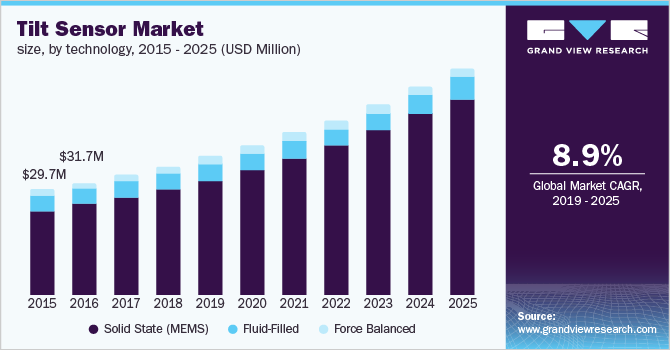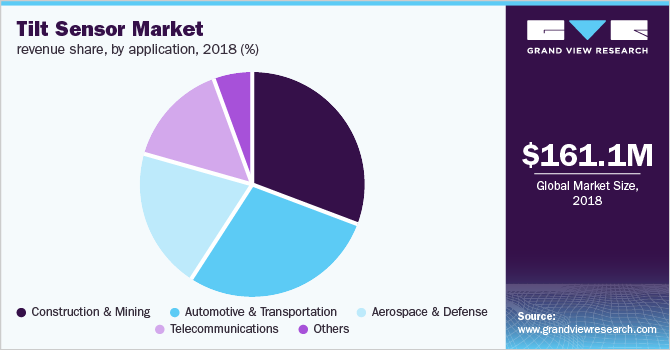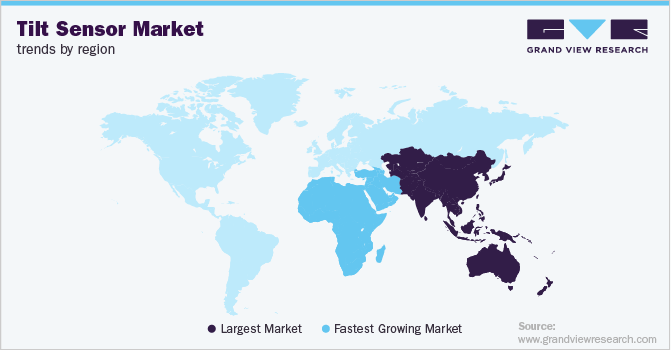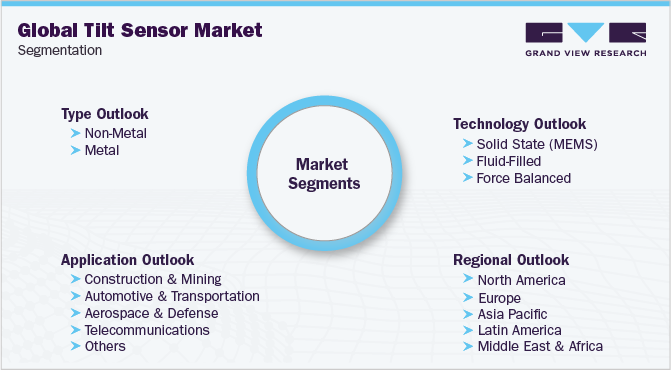- Home
- »
- Sensors & Controls
- »
-
Tilt Sensor Market Size, Share, Growth Analysis Report, 2025GVR Report cover
![Tilt Sensor Market Size, Share & Trends Report]()
Tilt Sensor Market Size, Share & Trends Analysis Report By Housing Material Type, By Technology (Solid State (MEMS), Fluid-filled, Force Balanced), By Application, By Region, And Segment Forecasts, 2019 - 2025
- Report ID: GVR-3-68038-720-9
- Number of Report Pages: 170
- Format: PDF, Horizon Databook
- Historical Range: 2015 - 2017
- Forecast Period: 2019 - 2025
- Industry: Semiconductors & Electronics
Report Overview
The global tilt sensor market size to be valued at USD 288.7 million by 2025 and is expected to grow at a compound annual growth rate (CAGR) of 8.9% during the forecast period. The market has witnessed steady growth over the years owing to rising demand for these devices from smartphones, automobiles, ships, laptops, gaming consoles, and land-based satellite communication device manufacturers. Furthermore, increased demand is expected from construction, agriculture, mining, transportation, and industrial automation sectors. These are a few major reasons expected to boost the growth prospects of the market over the forecast period.

The usage of and demand for tilt sensors has notably increased over the past few years. Tilt sensors have developed gradually from ordinary mechanical pendulum-like devices to fluid-filled electrolytic-type devices to MEMS-based digital sensors. For a long time, tilt sensors were used only to measure safety parameters such as boom angles and vehicle reaction in the automotive sector. As the technology evolved and safety regulations ensured workers’ protection, these devices can be easily integrated with other devices for various applications. Due to ongoing research activities, these devices are now being used to drive innovation in areas such as drivers’ comfort in automobiles.
A tilt sensor produces an electric signal with an angular movement and is used to measure slope with a finite range of motion. Construction equipment manufacturers are also realizing the importance of deploying tilt sensors to avoid serious mishaps at construction sites. These devices are specially used in scissor lifts, telehandlers, boom lifts, and aerial work platforms (AWP) for appropriate monitoring of tilt angles at construction sites and avoiding mishaps such as collisions, falling, entrapment, and crane overturning. These devices aid in monitoring the chassis tilt angle, platform tilt angle, and the platform height of a variety of heavy machinery used at construction sites.
The safety of workers continues to be paramount in the agriculture sector. Safe operation of agricultural vehicles such as tractors, cranes, man-lifts, off-road vehicles, and lift platforms is essential to avoid any mishaps to the operator or people around. Moreover, the emphasis of these industries on the use of autonomous control functions has notably increased over the years. These factors and the increased need for efficiency of these vehicles, safety, and operator comfort have made sensors with special emphasis on tip-over protection and platform leveling and tilt alarms indispensable in these industries.
In the U.S. and several European countries, stringent safety regulations are in place to promote workers’ safety. Similarly, in the Asian Pacific region, with a large number of infrastructure projects in the pipeline, focus on safety regulations is increasing. All manufacturers of heavy vehicles such as cranes, lift platforms, and other kinds of construction and agricultural equipment are required to incorporate sensors in their products to ensure maximum safety and smooth operation. Additionally, industrial equipment manufacturers need to adhere to government regulations concerning Electro Magnetic Compatibility (EMC) of the equipment.
Moreover, as the technology has evolved and tilt sensors have moved from being analog to digital, the number of ways tilt sensors can be integrated into a range of applications has also increased. Digital sensors are more resistant to interference from analog signals and the shift from analog to digital sensors is taking place at a rapid pace in countries such as the U.S., Japan, Singapore, Sweden, Norway, Switzerland, and Finland. Digital sensors are also more precise when it comes to data conversion adaptable to CAN or BUS outputs.
Tilt Sensor Market Trends
The widespread use of Micro ElectroMechanical Systems (MEMS) technology in a variety of verticals due to its small size and inexpensive cost, which influence market growth. The dependency of industries on advanced automated functions expanded over time. Sensors placed on tip-over protection, platform leveling, and tilt alerts have become increasingly important in different industries in terms of these qualities, as well as the growing market for vehicle efficiency, safety, and operator comfort is expected to drive the market growth.
The high price of tilt sensors and growing competition is further expected to hamper the market expansion.
The expanding use of these sensors that provide data on the leaning position of items help to improve the industry. The use of tilt or slant sensors in the automotive sector is increasing. There are commonly employed along with gyroscopes to increase the passenger safety and vehicle efficiency thereby contributing to the market growth.
The Covid-19 has influenced the tilt sensor market. The low investment expenditures and a lack of movement had restricted the tilt sensor technology sales and production. However, the with the introduction of new safety protocols issued by authorities on a global level is expected to develop the practices to adopt new normal conditions.
Material Insights
Based on the housing material type, the market has been classified into non-metal and metal. The non-metal segment accounted for a dominant share of over 65% in 2018 and is likely to retain its dominance over the forecast period. This can be attributed to the huge demand for tilt sensors that incorporate a high-grade plastic housing material. The segment is also likely to emerge as the fastest-growing segment over the forecast period.
Due to the unique properties of tilt sensors housed in high-grade plastic such as compact size and easy installation, they provide a high degree of ingress protection. Tilt sensors made from materials such as aluminum and stainless steel also find use in a variety of applications. However, the demand for these tilt sensors is likely to remain much lower as compared to non-metal tilt sensors over the forecast period.
Technology Insights
Based on technology, the tilt sensor market is classified into a solid-state (MEMS), fluid-filled, and force balanced. Solid-state electromechanical MEMS sensors are easy to install and have integral signal conditioning; however, their thermal coefficients are extremely high and it is difficult to obtain accuracy using them in most applications. Because for their compact size, they fit easily into the required machine or component to measure tilt angles. Owing to this, there is a high demand for solid-state tilt sensors and the segment is expected to dominate over the forecast period.
Fluid-filled sensors are of two types: electrolytic tilt sensors and capacitive tilt sensors. Whereas capacitive tilt sensors are capable of making non-contact measurements of inclination and tilt and operate as a sensor as well as a switch, electrolytic tilt sensors can produce accurate pitch and roll measurements in many applications. Fluid-filled sensors have a low cost to performance ratio; however, their slow response time makes them less preferred compared to the MEMS sensor. Force balanced sensors are gravity referenced inclinometers or tilt sensors that measure angles with high accuracy and a broad measurement range. However, the high cost of these sensors acts as a deterrent to the segment’s growth prospects.
Application Insights
The market is segmented based on application into construction & mining, automotive & transportation, aerospace & defense, telecommunications, and others. Of these, the aerospace & defense segment is expected to register the highest CAGR over the forecast period, followed by the telecommunications segment. In the construction sector, tilt sensors are used to measure the chassis angle to prevent heavy machines from losing their balance and tipping over. Furthermore, for elevated platforms, these sensors are used to measure the chassis tilt angle to avoid boom movement or platform height increase.
In the mining sector, tilt sensors are used for measuring inertial, tilt, vibration, and seismic activities. In the automotive sector, these sensors are used to develop air-bag systems, electronic stability controls, and tilt angle measurement solutions. In the transportation sector, these devices are typically used in hydraulic leveling systems in RV safety and functionality, giving stability to parked vehicles on uneven grounds. In aircraft, these sensors are used to measure the tilt in multiple axes of a reference plane.

In the telecommunications sector, these sensors are used to monitor the tilt angle of the communication tower in real-time and safety measures are taken accordingly to avoid unwanted accidents. Similarly, the other segment in the report includes applications such as robots, smartphone joysticks, laptops, video cameras, thermostats, and tablets. In smartphones, tilt sensors are used to aid in the auto-rotate function of the phone.
In the aerospace sector, for instance, these devices are used to help pilots execute stunts at high speed with amazing precision. Pilots use super-fast machinery for their aerobatics stunts and tilt sensors are used as transducers in the critical parts of the plane’s computer-assisted circuitry. Typically, these devices aid pilots in understanding the horizontal and vertical inclination of airplanes so that the pilots can deal with obstacles during maneuvering. These devices emit an electric signal proportional to the inclination degree concerning one or more axes, thereby helping the pilot in the decision-making process.
Regional Insights
Among the key regional markets covered in the report, Asia Pacific currently dominates the market. The regional market is also expected to register the highest CAGR over the forecast period due to the steady expansion of industries and sectors such as aerospace, defense, automotive, construction, mining, and transportation. The Middle East and African regional market are also expected to display a considerable amount of growth prospects over the forecast period. This can be attributed to the steady growth opportunities expected in industries and sectors such as agriculture, automotive, construction, mining, and transportation, which is expected to increase the demand for tilt sensors.

It is estimated that the prices of tilt sensors will decline over the forecast period. However, the demand for tilt sensors is anticipated to increase manifold in a range of end-use applications. As a result, the unit shipments of these products are expected to increase during the forecast period.
Key Companies & Market Share Insights
The market is highly fragmented owing to the presence of several players trying to compete with one another. To survive the rising competition, key industry players are emphasizing on investing in research & development activities, entering into partnerships with established players, and focusing on enhancing their distribution strategies by collaborating with global distributors. The distribution of tilt sensors through a robust network of third-party partners in various countries also helps key companies strengthen their positions in the global market.
For instance, Variohm Group acquired Positek in May 2019. This acquisition is likely to help the Variohm Group expand its overall customer support and production capability and distribution channels in several industrial markets. Some of the prominent players in the tilt sensor market include:
-
TE Connectivity
-
Murata Manufacturing Co., Ltd
-
SICK AG
-
Pepperl+Fuchs AG
-
Level Developments Ltd
-
The Fredericks Company
-
MEMSIC Inc
-
ifm electronic gmbh
-
Balluff GmbH
-
Jewel Instruments LLC
-
elobau GmbH & Co. KG
-
Gefran
Recent Developments
-
In August 2022, SICK enhanced the capabilities of the FTMg flow measurement device for continuous and intelligent monitoring of compressed air networks and connected consumers.The multi-function sensor for up to eight process parameters offers the new nominal diameters of DN40 and DN50 for mechanical integration.
-
In March 2022, Murata introduced a new MEMS (Micro-Electro-Mechanical Systems) inclinometerwhich offers strong stability and offset performance over its lifetime and temperature.The new SCL3400 features a digital SPI communication interface and two measurement axes.
-
In January 2022, ComNav Technology revealed an improvement to the T300 Plus GNSS and T300 receivers for the international market. It is an improvement to the fresh GNSS-K8 platform for the receivers and a tilt sensor substitute for the T300 Plus IMU capsule.
-
In December 2021, Yokohama National University invented a tilt sensor that utilizes a conductive liquid substance to capture digital binary signals. The device could acquire tilt information utilizing binary signals like DC on/off conditions, helping the team to monitor tilt angle and alignment in two dimensions at the same time.
-
In March 2021, Level Developments launched three new variations of inclinometer sensors with a digital display attachment. Previously sold as two separate products, they are now available in one set to allow convenience and quick setup.
-
In February 2021, Jewell Instruments launched the updated version of the single or dual-axis JDI-100/200 MEMS inclinometer series that includes additional output and connector options, including wired, 8-pin, and dual Deutsch connectors. In addition to ASCII RS-485, the JDI now offers ASCII RS-232 and MODBUS RS-485 digital outputs.
Tilt Sensor Market Report Scope
Report Attribute
Details
The market size value in 2020
USD 186.6 million
The revenue forecast in 2025
USD 288.7 million
Growth Rate
CAGR of 8.9% from 2019 to 2025
The base year for estimation
2018
Historical data
2015 - 2017
Forecast period
2019 - 2025
Quantitative units
Revenue in USD million, volume in thousand units and CAGR from 2019 to 2025
Report coverage
Revenue forecast, company ranking, competitive landscape, growth factors, and trends
Segments covered
Housing material type, technology, application, region
Regional scope
North America; Europe; Asia Pacific; Latin America; MEA
Country scope
U.S.; Canada; U.K.; Germany; India; Japan; China; Brazil; Colombia
Key companies profiled
TE Connectivity; Murata Manufacturing Co. Ltd; SICK AG; Pepperl+Fuchs AG; Level Developments Ltd; The Fredericks Company; MEMSIC Inc; ifm electronic gmbh; Balluff GmbH; Jewel Instruments LLC; elobau GmbH & Co. KG; Gefran.
Customization scope
Free report customization (equivalent up to 8 analysts working days) with purchase. Addition or alteration to country, regional & segment scope.
Pricing and purchase options
Avail customized purchase options to meet your exact research needs. Explore purchase options
Global Tilt Sensor Market SegmentationThis report forecasts revenue growth at global, regional, and country levels and provides an analysis of the latest industry trends in each of the sub-segments from 2015 to 2025. For this study, Grand View Research has segmented the global tilt sensor market report based on housing material type, technology, application, and region:

-
Housing Material Type Outlook (Volume, Thousand Units; Revenue, USD Million, 2015 - 2025)
-
Non-Metal
-
Metal
-
-
Technology Outlook (Volume, Thousand Units; Revenue, USD Million, 2015 - 2025)
-
Solid State (MEMS)
-
Fluid-Filled
-
Force Balanced
-
-
Application Outlook (Volume, Thousand Units; Revenue, USD Million, 2015 - 2025)
-
Construction & Mining
-
Automotive & Transportation
-
Aerospace & Defense
-
Telecommunications
-
Others
-
-
Regional Outlook (Volume, Thousand Units; Revenue, USD Million, 2015 - 2025)
-
North America
-
The U.S.
-
Canada
-
-
Europe
-
Germany
-
U.K.
-
-
Asia Pacific
-
China
-
India
-
Japan
-
-
Latin America
-
Brazil
-
Colombia
-
-
Middle East & Africa (MEA)
-
Frequently Asked Questions About This Report
b. The global tilt sensor market size was estimated at USD 173.1 million in 2019 and is expected to reach USD 186.6 million in 2020.
b. The global tilt sensor market is expected to grow at a compound annual growth rate of 8.9% from 2019 to 2025 to reach USD 288.7 million by 2025.
b. The Asia Pacific dominated the tilt sensor market with a share of 50.9% in 2019. This is attributable to the steady expansion of industries and sectors such as aerospace, defense, automotive, construction, mining, and transportation.
b. Some key players operating in the tilt sensor market include TE Connectivity, Murata Manufacturing Co., Ltd, SICK AG, Pepperl+Fuchs AG, Level Developments Ltd, The Fredericks Company, MEMSIC Inc, ifm electronic gmbh, Balluff GmbH, Jewel Instruments LLC, elobau GmbH & Co. KG, and Gefran.
b. Key factors that are driving the market growth include growing demand for construction equipment, movable work platforms, aerial lifts and tipping trucks across the globe, and increasing demand for MEMS tilt sensors.
Share this report with your colleague or friend.
![gvr icn]()
NEED A CUSTOM REPORT?
We can customize every report - free of charge - including purchasing stand-alone sections or country-level reports, as well as offer affordable discounts for start-ups & universities. Contact us now
![Certified Icon]()
We are GDPR and CCPA compliant! Your transaction & personal information is safe and secure. For more details, please read our privacy policy.
We are committed towards customer satisfaction, and quality service.
"The quality of research they have done for us has been excellent."





